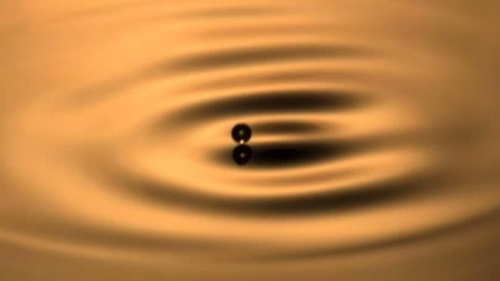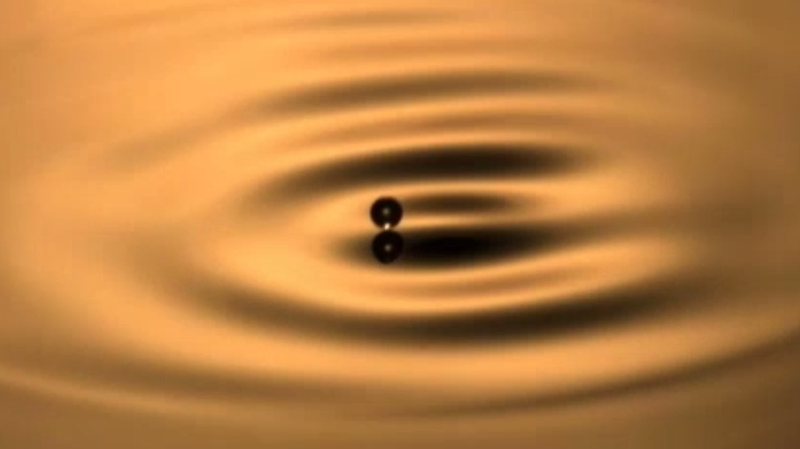Surface Waves Store Bouncing Droplet’s History
A splash in a liquid can sometimes leave a droplet bouncing temporarily on the wavy liquid surface, before the two merge. A research team has now shown that such a drop, when propelled on a meandering path by self-generated waves, can reverse its path exactly, using information stored in the waves, even when the drop’s motion is chaotic and unpredictable. This time reversibility is not usually possible for chaotically moving particles, but here it exploits the fact that the drop/wave system acts like a sort of information machine. The work makes an unexpected connection between two apparently different topics: chaotic dynamics and computation.
The motions of interacting objects from molecules to planets can sometimes become chaotic—so unpredictable that they appear random. One classic example of chaos involves billiard balls rolling and colliding on a table. For a rectangular table, the motions are regular and predictable and can generally be reversed in time, at least in principle. One could reverse the balls’ velocities at every instant, and they would retrace their paths. But if the billiard table has a more unusual shape, such as a stadium shape with semicircular ends, then the balls move chaotically, and the motion is not time reversible. Chaos makes later trajectories exquisitely sensitive to earlier ones, so an immeasurably small difference between two initial paths or velocities rapidly leads to two very different trajectories at later times; the balls’ starting motions are in effect “forgotten.” This time irreversibility holds for all systems of chaotic particles, whereas chaotic waves are generally reversible.
Now Emmanuel Fort of the Institute of Industrial Physics and Chemistry (ESPCI ParisTech) and his colleagues have shown that, for a liquid drop bouncing along a path on the surface of a bath of the same liquid, chaos is no obstacle to time reversibility. Fort and colleagues had previously used this setup to mimic phenomena in optics, acoustics, and quantum mechanics [1, 2].
In their latest experiments, using silicone oil as the liquid, they followed the drop’s motion as it was driven by surface waves along a chaotic path. The waves were produced by the impact of the drop but were fed with energy from a mechanical oscillator vibrating the bath. The researchers kept the drop’s path within a confined space by mixing the oil with a fluid containing magnetic particles and then using a magnetic field to confine the drop within a circular “well.” For a certain range of well sizes (and thus of resonant wave frequencies within the well) the drop bounced along a looping, chaotic path bounded by the well.
Fort and colleagues could reverse the drop’s trajectory by suddenly reversing the phase, or direction of motion, of the waves by reversing the mechanical oscillator, essentially making the waves go up when previously they had gone down. The team found that, even if it was moving chaotically, the drop could retrace its jumps fairly accurately. The researchers say that the information about the drop’s previous path was stored in the wave field (pattern of waves) and so could be recovered [3].
In the team’s experiments, as the drop bounces around, it alters the wave field by exciting a new ripple each time it hits the surface. When the motion is reversed, each bounce in the backwards direction excites a new wave of opposite phase to the original one, canceling it out. So the drop erases the previous information as it goes.
“By coupling a particle to an extended wave field, the dynamical information that will pilot the drop is spread out in the wave field,” says team member Stephane Perrard, who participated from Paris Diderot University but is now at the University of Chicago. “This spreading insures protection against the sensitivity to initial conditions.”
The drop/wave system displays all of the basic capabilities of a computer: writing, storing, reading, and erasing information. In this respect it resembles the “universal computer” posited by Alan Turing, the pioneer of computational theory. The researchers haven’t yet come up with a way of using their “wave Turing machine” for computation, but Perrard says it might be possible in the future. The challenge is that the operations are “global”—they involve the wave field throughout the whole system—and so the usual distinction between processor and memory is absent.
“The time reversibility demonstrated in this paper is a new and fascinating feature of this extraordinarily rich system and particularly striking in the chaotic regime,” says fluid dynamicist John Bush of the Massachusetts Institute of Technology in Cambridge. He adds that the connection with information theory is “a provocative idea.”
This research is published in Physical Review Letters.
–Philip Ball
Philip Ball is a freelance science writer in London. His latest book is How Life Works (Picador, 2024).
References
- Y. Couder, S. Protière, E. Fort, and A. Boudaoud, “Dynamical Phenomena: Walking and Orbiting Droplets,” Nature 437, 208 (2005).
- J. M. W. Bush, “Pilot-Wave Hydrodynamics,” Annu. Rev. Fluid Mech. 47, 269 (2015).
- A. Eddi, E. Sultan, J. Moukhtar, E. Fort, M. Rossi, and Y. Couder, “Information Stored in Faraday Waves: The Origin of a Path Memory,” J. Fluid Mech. 674, 433 (2011).





